International Marketing: Pizza Hut Entry Strategy Analysis Report
VerifiedAdded on 2023/06/05
|30
|7309
|208
Report
AI Summary
This report offers a comprehensive analysis of international marketing strategies, focusing on market entry modes and their application. Part 1 critically evaluates hierarchical market entry modes, providing examples of international companies implementing each strategy, along with their advantages and disadvantages. Part 2 delves into Pizza Hut's franchise strategy in India, evaluating its success through SWOT and PESTLE analyses, competitor analysis (Dominos), and a critical review of its marketing plan, including digital marketing aspects. Part 3 provides recommendations for Pizza Hut's future international market entry, specifically exploring the potential of entering Nigeria through franchising, considering global citizenship, cultural factors, and associated political, technological, and economic risks. The report provides a detailed examination of international market planning, particularly within the context of Pizza Hut's franchise model.
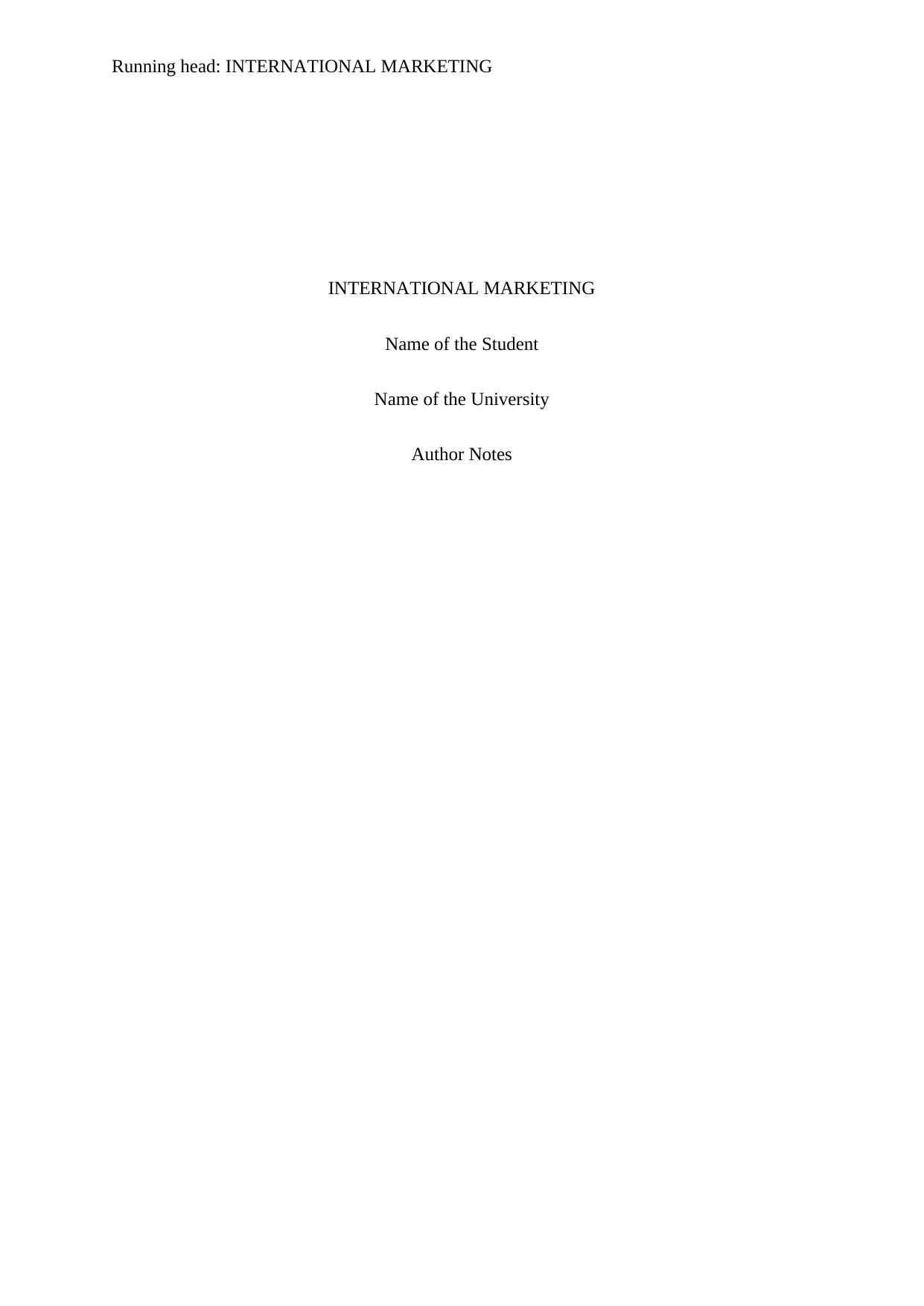
Running head: INTERNATIONAL MARKETING
INTERNATIONAL MARKETING
Name of the Student
Name of the University
Author Notes
INTERNATIONAL MARKETING
Name of the Student
Name of the University
Author Notes
Paraphrase This Document
Need a fresh take? Get an instant paraphrase of this document with our AI Paraphraser
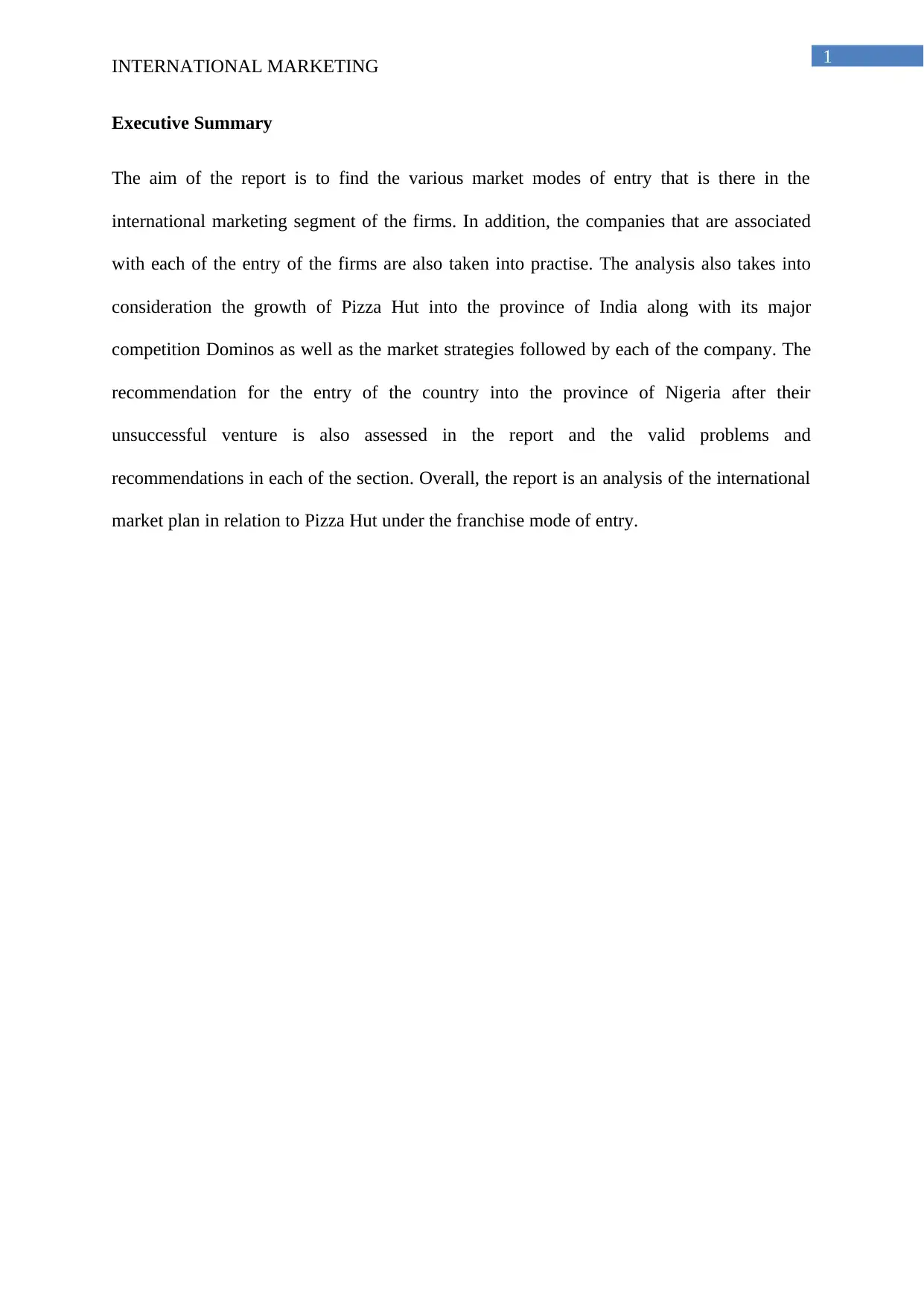
1
INTERNATIONAL MARKETING
Executive Summary
The aim of the report is to find the various market modes of entry that is there in the
international marketing segment of the firms. In addition, the companies that are associated
with each of the entry of the firms are also taken into practise. The analysis also takes into
consideration the growth of Pizza Hut into the province of India along with its major
competition Dominos as well as the market strategies followed by each of the company. The
recommendation for the entry of the country into the province of Nigeria after their
unsuccessful venture is also assessed in the report and the valid problems and
recommendations in each of the section. Overall, the report is an analysis of the international
market plan in relation to Pizza Hut under the franchise mode of entry.
INTERNATIONAL MARKETING
Executive Summary
The aim of the report is to find the various market modes of entry that is there in the
international marketing segment of the firms. In addition, the companies that are associated
with each of the entry of the firms are also taken into practise. The analysis also takes into
consideration the growth of Pizza Hut into the province of India along with its major
competition Dominos as well as the market strategies followed by each of the company. The
recommendation for the entry of the country into the province of Nigeria after their
unsuccessful venture is also assessed in the report and the valid problems and
recommendations in each of the section. Overall, the report is an analysis of the international
market plan in relation to Pizza Hut under the franchise mode of entry.
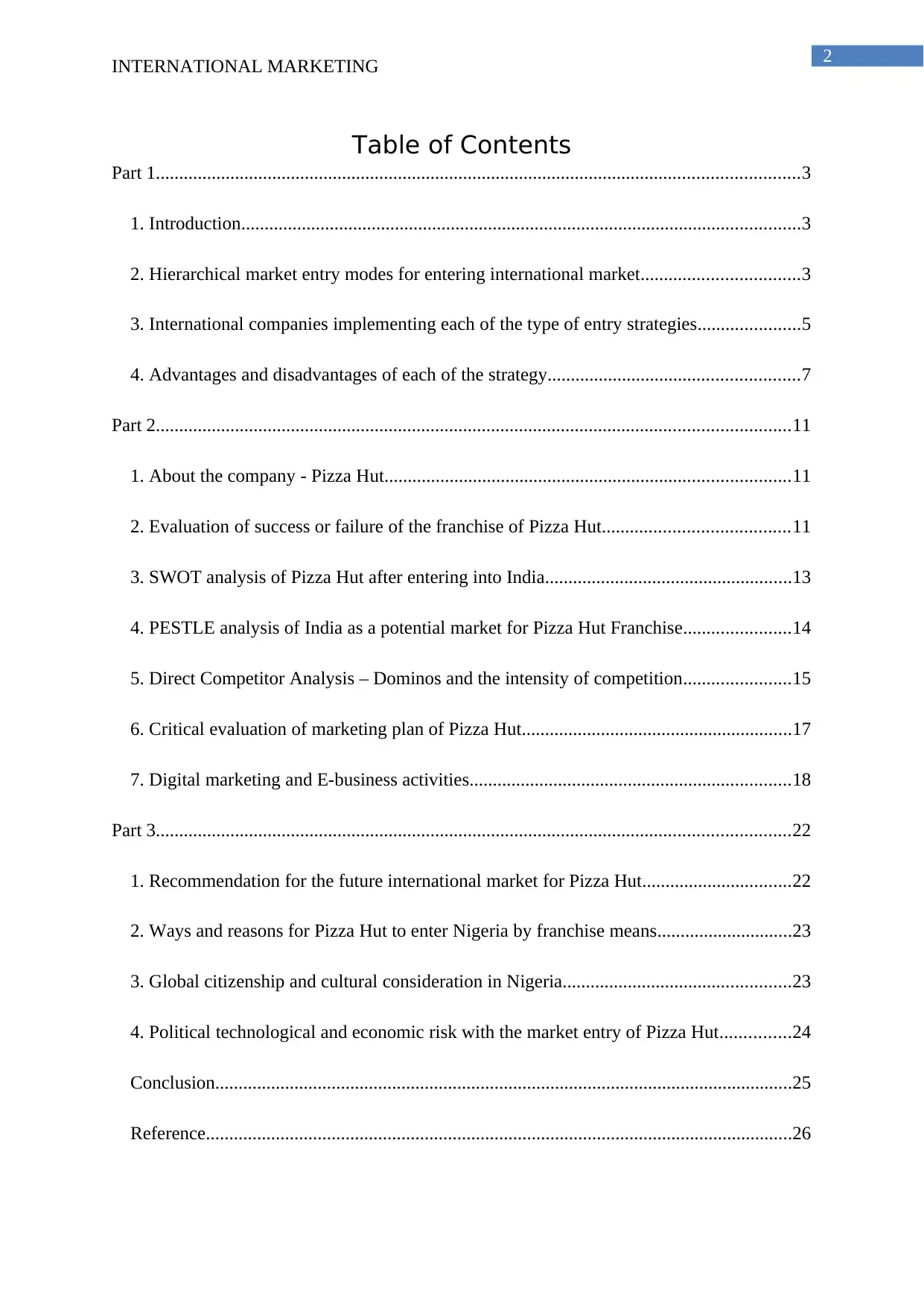
2
INTERNATIONAL MARKETING
Table of Contents
Part 1..........................................................................................................................................3
1. Introduction........................................................................................................................3
2. Hierarchical market entry modes for entering international market..................................3
3. International companies implementing each of the type of entry strategies......................5
4. Advantages and disadvantages of each of the strategy......................................................7
Part 2........................................................................................................................................11
1. About the company - Pizza Hut.......................................................................................11
2. Evaluation of success or failure of the franchise of Pizza Hut........................................11
3. SWOT analysis of Pizza Hut after entering into India.....................................................13
4. PESTLE analysis of India as a potential market for Pizza Hut Franchise.......................14
5. Direct Competitor Analysis – Dominos and the intensity of competition.......................15
6. Critical evaluation of marketing plan of Pizza Hut..........................................................17
7. Digital marketing and E-business activities.....................................................................18
Part 3........................................................................................................................................22
1. Recommendation for the future international market for Pizza Hut................................22
2. Ways and reasons for Pizza Hut to enter Nigeria by franchise means.............................23
3. Global citizenship and cultural consideration in Nigeria.................................................23
4. Political technological and economic risk with the market entry of Pizza Hut...............24
Conclusion............................................................................................................................25
Reference..............................................................................................................................26
INTERNATIONAL MARKETING
Table of Contents
Part 1..........................................................................................................................................3
1. Introduction........................................................................................................................3
2. Hierarchical market entry modes for entering international market..................................3
3. International companies implementing each of the type of entry strategies......................5
4. Advantages and disadvantages of each of the strategy......................................................7
Part 2........................................................................................................................................11
1. About the company - Pizza Hut.......................................................................................11
2. Evaluation of success or failure of the franchise of Pizza Hut........................................11
3. SWOT analysis of Pizza Hut after entering into India.....................................................13
4. PESTLE analysis of India as a potential market for Pizza Hut Franchise.......................14
5. Direct Competitor Analysis – Dominos and the intensity of competition.......................15
6. Critical evaluation of marketing plan of Pizza Hut..........................................................17
7. Digital marketing and E-business activities.....................................................................18
Part 3........................................................................................................................................22
1. Recommendation for the future international market for Pizza Hut................................22
2. Ways and reasons for Pizza Hut to enter Nigeria by franchise means.............................23
3. Global citizenship and cultural consideration in Nigeria.................................................23
4. Political technological and economic risk with the market entry of Pizza Hut...............24
Conclusion............................................................................................................................25
Reference..............................................................................................................................26
⊘ This is a preview!⊘
Do you want full access?
Subscribe today to unlock all pages.

Trusted by 1+ million students worldwide

3
INTERNATIONAL MARKETING
Part 1
1. Introduction
In a world of globalisation, there are a number of companies, both new and existent
which are interested to venture into the international market and make a mark for themselves
in the world of business. De Villa, Rajwani and Lawton (2015) states that the companies as
well as the industries make sure to enter the market by the means of a number of entry modes
that do make sure to cover every aspects of the entering into the international market to make
a niche for themselves in the overall business arena. The various types of market entry modes
help the company to have base in the various international markets in which the company is
interested to operate. The following report is an analysis of the different marketing modes
that are required for a company to enter the international market in a hierarchical order. In
addition, the various companies that have implemented each of the type of the strategies for
the entry in the international market have been addressed along with the required advantages
and disadvantages of each of the strategy or the entry of the marketing modes. The following
paragraphs highlight the summary of the overall analysis in the report in a precise manner.
2. Hierarchical market entry modes for entering international market
The market entry mode is defined as the way or the strategical methods by which the
goods and services of a particular market enters or aims to enter into a new market which has
been targeted and aimed to be achieved. Laufs and Schwens (2014) states that in the modern
age there is a specific need of entering into a new market other than the proposed niche
market to increase their sales and improve brand awareness and even the stability of the
business in the new market. The market entry of a specific company is however is to be
operated by keeping in mind the competitor analysis as well as the increase customer base for
the companies. There are a number of ways in which the companies can establish their modes
of entry into the foreign market which are as follows –
INTERNATIONAL MARKETING
Part 1
1. Introduction
In a world of globalisation, there are a number of companies, both new and existent
which are interested to venture into the international market and make a mark for themselves
in the world of business. De Villa, Rajwani and Lawton (2015) states that the companies as
well as the industries make sure to enter the market by the means of a number of entry modes
that do make sure to cover every aspects of the entering into the international market to make
a niche for themselves in the overall business arena. The various types of market entry modes
help the company to have base in the various international markets in which the company is
interested to operate. The following report is an analysis of the different marketing modes
that are required for a company to enter the international market in a hierarchical order. In
addition, the various companies that have implemented each of the type of the strategies for
the entry in the international market have been addressed along with the required advantages
and disadvantages of each of the strategy or the entry of the marketing modes. The following
paragraphs highlight the summary of the overall analysis in the report in a precise manner.
2. Hierarchical market entry modes for entering international market
The market entry mode is defined as the way or the strategical methods by which the
goods and services of a particular market enters or aims to enter into a new market which has
been targeted and aimed to be achieved. Laufs and Schwens (2014) states that in the modern
age there is a specific need of entering into a new market other than the proposed niche
market to increase their sales and improve brand awareness and even the stability of the
business in the new market. The market entry of a specific company is however is to be
operated by keeping in mind the competitor analysis as well as the increase customer base for
the companies. There are a number of ways in which the companies can establish their modes
of entry into the foreign market which are as follows –
Paraphrase This Document
Need a fresh take? Get an instant paraphrase of this document with our AI Paraphraser

4
INTERNATIONAL MARKETING
1. Direct Exports – Direct Exports is defined as the basic form of exporting in which the
direct holding of a company is to be done and the economies of scale are being capitalised in
the matters of production from the home country to some other foreign countries in order to
get better business and work (Maekelburger, Schwens and Kabst 2012, pp.458-476). This
form of exports is best for the business that concerns with small amounts of goods without
any form of intermediaries. There are a various types of direct exports namely the sales
representative and importing distributors.
2. Indirect Exports – Indirect export is defined as the process of export in which the process
of transaction is done intermediaries and in which the exporter has no control over the
products. This kind of business is done for the companies which has large business scale.
3. Licensing – Licensing is defined as the type of market entry modes in which the licensing
agreement is done by the foreign companies in order to manufacture as well as market a
product which is either exclusive or nonexclusive in the matter. There is limited rights and
resources for the manufacturing of the product in the span of time (Park et al. 2012).
4. Franchising – The whole matter of franchising is defined as the system or a way in which
the company is independent and also pays fees or royalty bonus to the mother concern for
allowing them to make sure that their production is not being hampered in any sense (Ang,
Benischke and Doh 2015, p 1536-1553). The concept of franchising is for a longer period of
time compared to licensing process as it adheres to the intellectual property rights of the
company including lower political and cost risk.
5. Turnkey Projects – The project is defined as the form in which the clients pay the liable
contractors to design and construct and train the facilities and personnel’s in the required span
of time. In this way the technology and other forms of products are exported to the rivals for
the advantage of the company.
INTERNATIONAL MARKETING
1. Direct Exports – Direct Exports is defined as the basic form of exporting in which the
direct holding of a company is to be done and the economies of scale are being capitalised in
the matters of production from the home country to some other foreign countries in order to
get better business and work (Maekelburger, Schwens and Kabst 2012, pp.458-476). This
form of exports is best for the business that concerns with small amounts of goods without
any form of intermediaries. There are a various types of direct exports namely the sales
representative and importing distributors.
2. Indirect Exports – Indirect export is defined as the process of export in which the process
of transaction is done intermediaries and in which the exporter has no control over the
products. This kind of business is done for the companies which has large business scale.
3. Licensing – Licensing is defined as the type of market entry modes in which the licensing
agreement is done by the foreign companies in order to manufacture as well as market a
product which is either exclusive or nonexclusive in the matter. There is limited rights and
resources for the manufacturing of the product in the span of time (Park et al. 2012).
4. Franchising – The whole matter of franchising is defined as the system or a way in which
the company is independent and also pays fees or royalty bonus to the mother concern for
allowing them to make sure that their production is not being hampered in any sense (Ang,
Benischke and Doh 2015, p 1536-1553). The concept of franchising is for a longer period of
time compared to licensing process as it adheres to the intellectual property rights of the
company including lower political and cost risk.
5. Turnkey Projects – The project is defined as the form in which the clients pay the liable
contractors to design and construct and train the facilities and personnel’s in the required span
of time. In this way the technology and other forms of products are exported to the rivals for
the advantage of the company.
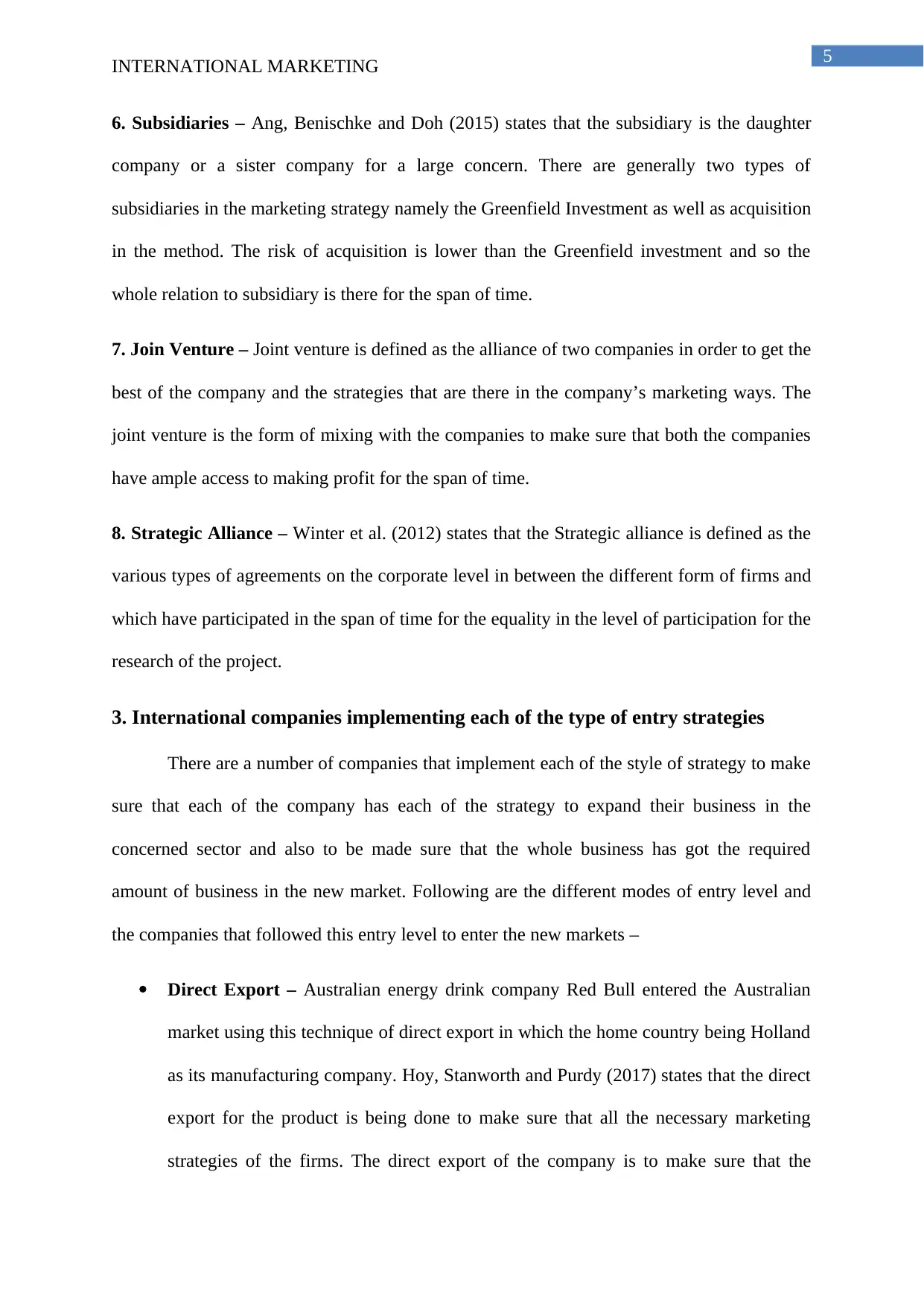
5
INTERNATIONAL MARKETING
6. Subsidiaries – Ang, Benischke and Doh (2015) states that the subsidiary is the daughter
company or a sister company for a large concern. There are generally two types of
subsidiaries in the marketing strategy namely the Greenfield Investment as well as acquisition
in the method. The risk of acquisition is lower than the Greenfield investment and so the
whole relation to subsidiary is there for the span of time.
7. Join Venture – Joint venture is defined as the alliance of two companies in order to get the
best of the company and the strategies that are there in the company’s marketing ways. The
joint venture is the form of mixing with the companies to make sure that both the companies
have ample access to making profit for the span of time.
8. Strategic Alliance – Winter et al. (2012) states that the Strategic alliance is defined as the
various types of agreements on the corporate level in between the different form of firms and
which have participated in the span of time for the equality in the level of participation for the
research of the project.
3. International companies implementing each of the type of entry strategies
There are a number of companies that implement each of the style of strategy to make
sure that each of the company has each of the strategy to expand their business in the
concerned sector and also to be made sure that the whole business has got the required
amount of business in the new market. Following are the different modes of entry level and
the companies that followed this entry level to enter the new markets –
Direct Export – Australian energy drink company Red Bull entered the Australian
market using this technique of direct export in which the home country being Holland
as its manufacturing company. Hoy, Stanworth and Purdy (2017) states that the direct
export for the product is being done to make sure that all the necessary marketing
strategies of the firms. The direct export of the company is to make sure that the
INTERNATIONAL MARKETING
6. Subsidiaries – Ang, Benischke and Doh (2015) states that the subsidiary is the daughter
company or a sister company for a large concern. There are generally two types of
subsidiaries in the marketing strategy namely the Greenfield Investment as well as acquisition
in the method. The risk of acquisition is lower than the Greenfield investment and so the
whole relation to subsidiary is there for the span of time.
7. Join Venture – Joint venture is defined as the alliance of two companies in order to get the
best of the company and the strategies that are there in the company’s marketing ways. The
joint venture is the form of mixing with the companies to make sure that both the companies
have ample access to making profit for the span of time.
8. Strategic Alliance – Winter et al. (2012) states that the Strategic alliance is defined as the
various types of agreements on the corporate level in between the different form of firms and
which have participated in the span of time for the equality in the level of participation for the
research of the project.
3. International companies implementing each of the type of entry strategies
There are a number of companies that implement each of the style of strategy to make
sure that each of the company has each of the strategy to expand their business in the
concerned sector and also to be made sure that the whole business has got the required
amount of business in the new market. Following are the different modes of entry level and
the companies that followed this entry level to enter the new markets –
Direct Export – Australian energy drink company Red Bull entered the Australian
market using this technique of direct export in which the home country being Holland
as its manufacturing company. Hoy, Stanworth and Purdy (2017) states that the direct
export for the product is being done to make sure that all the necessary marketing
strategies of the firms. The direct export of the company is to make sure that the
⊘ This is a preview!⊘
Do you want full access?
Subscribe today to unlock all pages.

Trusted by 1+ million students worldwide
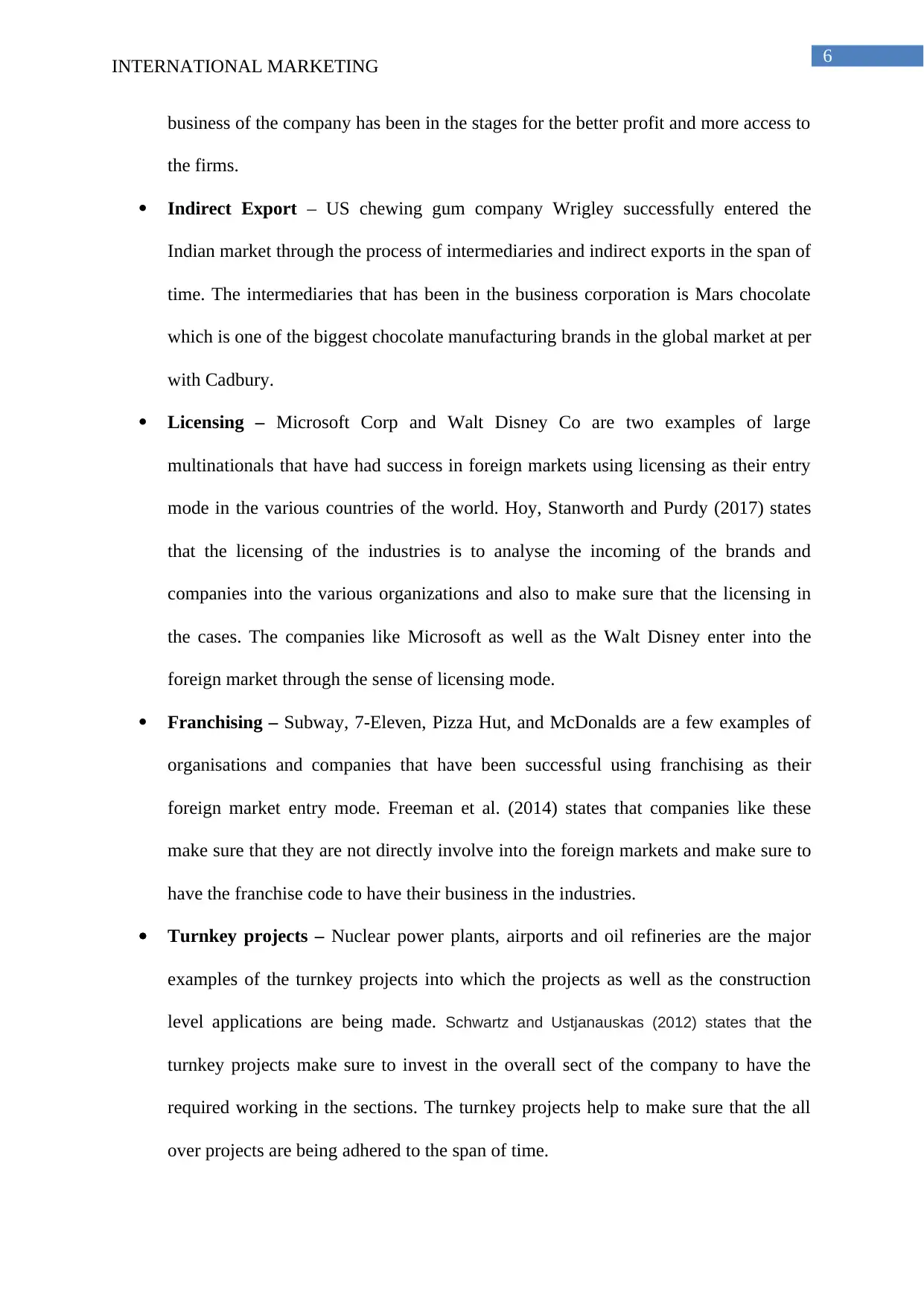
6
INTERNATIONAL MARKETING
business of the company has been in the stages for the better profit and more access to
the firms.
Indirect Export – US chewing gum company Wrigley successfully entered the
Indian market through the process of intermediaries and indirect exports in the span of
time. The intermediaries that has been in the business corporation is Mars chocolate
which is one of the biggest chocolate manufacturing brands in the global market at per
with Cadbury.
Licensing – Microsoft Corp and Walt Disney Co are two examples of large
multinationals that have had success in foreign markets using licensing as their entry
mode in the various countries of the world. Hoy, Stanworth and Purdy (2017) states
that the licensing of the industries is to analyse the incoming of the brands and
companies into the various organizations and also to make sure that the licensing in
the cases. The companies like Microsoft as well as the Walt Disney enter into the
foreign market through the sense of licensing mode.
Franchising – Subway, 7-Eleven, Pizza Hut, and McDonalds are a few examples of
organisations and companies that have been successful using franchising as their
foreign market entry mode. Freeman et al. (2014) states that companies like these
make sure that they are not directly involve into the foreign markets and make sure to
have the franchise code to have their business in the industries.
Turnkey projects – Nuclear power plants, airports and oil refineries are the major
examples of the turnkey projects into which the projects as well as the construction
level applications are being made. Schwartz and Ustjanauskas (2012) states that the
turnkey projects make sure to invest in the overall sect of the company to have the
required working in the sections. The turnkey projects help to make sure that the all
over projects are being adhered to the span of time.
INTERNATIONAL MARKETING
business of the company has been in the stages for the better profit and more access to
the firms.
Indirect Export – US chewing gum company Wrigley successfully entered the
Indian market through the process of intermediaries and indirect exports in the span of
time. The intermediaries that has been in the business corporation is Mars chocolate
which is one of the biggest chocolate manufacturing brands in the global market at per
with Cadbury.
Licensing – Microsoft Corp and Walt Disney Co are two examples of large
multinationals that have had success in foreign markets using licensing as their entry
mode in the various countries of the world. Hoy, Stanworth and Purdy (2017) states
that the licensing of the industries is to analyse the incoming of the brands and
companies into the various organizations and also to make sure that the licensing in
the cases. The companies like Microsoft as well as the Walt Disney enter into the
foreign market through the sense of licensing mode.
Franchising – Subway, 7-Eleven, Pizza Hut, and McDonalds are a few examples of
organisations and companies that have been successful using franchising as their
foreign market entry mode. Freeman et al. (2014) states that companies like these
make sure that they are not directly involve into the foreign markets and make sure to
have the franchise code to have their business in the industries.
Turnkey projects – Nuclear power plants, airports and oil refineries are the major
examples of the turnkey projects into which the projects as well as the construction
level applications are being made. Schwartz and Ustjanauskas (2012) states that the
turnkey projects make sure to invest in the overall sect of the company to have the
required working in the sections. The turnkey projects help to make sure that the all
over projects are being adhered to the span of time.
Paraphrase This Document
Need a fresh take? Get an instant paraphrase of this document with our AI Paraphraser
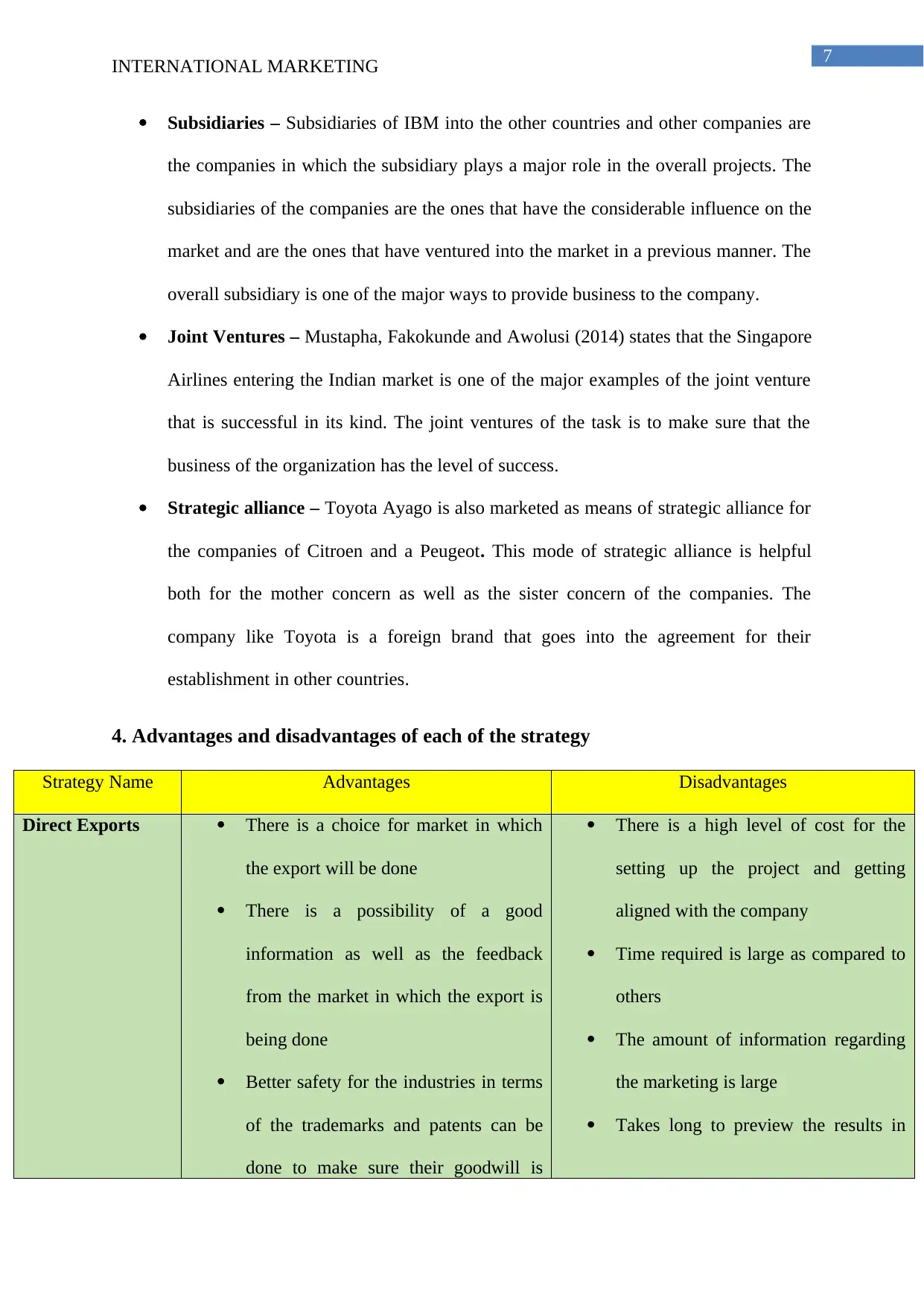
7
INTERNATIONAL MARKETING
Subsidiaries – Subsidiaries of IBM into the other countries and other companies are
the companies in which the subsidiary plays a major role in the overall projects. The
subsidiaries of the companies are the ones that have the considerable influence on the
market and are the ones that have ventured into the market in a previous manner. The
overall subsidiary is one of the major ways to provide business to the company.
Joint Ventures – Mustapha, Fakokunde and Awolusi (2014) states that the Singapore
Airlines entering the Indian market is one of the major examples of the joint venture
that is successful in its kind. The joint ventures of the task is to make sure that the
business of the organization has the level of success.
Strategic alliance – Toyota Ayago is also marketed as means of strategic alliance for
the companies of Citroen and a Peugeot. This mode of strategic alliance is helpful
both for the mother concern as well as the sister concern of the companies. The
company like Toyota is a foreign brand that goes into the agreement for their
establishment in other countries.
4. Advantages and disadvantages of each of the strategy
Strategy Name Advantages Disadvantages
Direct Exports There is a choice for market in which
the export will be done
There is a possibility of a good
information as well as the feedback
from the market in which the export is
being done
Better safety for the industries in terms
of the trademarks and patents can be
done to make sure their goodwill is
There is a high level of cost for the
setting up the project and getting
aligned with the company
Time required is large as compared to
others
The amount of information regarding
the marketing is large
Takes long to preview the results in
INTERNATIONAL MARKETING
Subsidiaries – Subsidiaries of IBM into the other countries and other companies are
the companies in which the subsidiary plays a major role in the overall projects. The
subsidiaries of the companies are the ones that have the considerable influence on the
market and are the ones that have ventured into the market in a previous manner. The
overall subsidiary is one of the major ways to provide business to the company.
Joint Ventures – Mustapha, Fakokunde and Awolusi (2014) states that the Singapore
Airlines entering the Indian market is one of the major examples of the joint venture
that is successful in its kind. The joint ventures of the task is to make sure that the
business of the organization has the level of success.
Strategic alliance – Toyota Ayago is also marketed as means of strategic alliance for
the companies of Citroen and a Peugeot. This mode of strategic alliance is helpful
both for the mother concern as well as the sister concern of the companies. The
company like Toyota is a foreign brand that goes into the agreement for their
establishment in other countries.
4. Advantages and disadvantages of each of the strategy
Strategy Name Advantages Disadvantages
Direct Exports There is a choice for market in which
the export will be done
There is a possibility of a good
information as well as the feedback
from the market in which the export is
being done
Better safety for the industries in terms
of the trademarks and patents can be
done to make sure their goodwill is
There is a high level of cost for the
setting up the project and getting
aligned with the company
Time required is large as compared to
others
The amount of information regarding
the marketing is large
Takes long to preview the results in
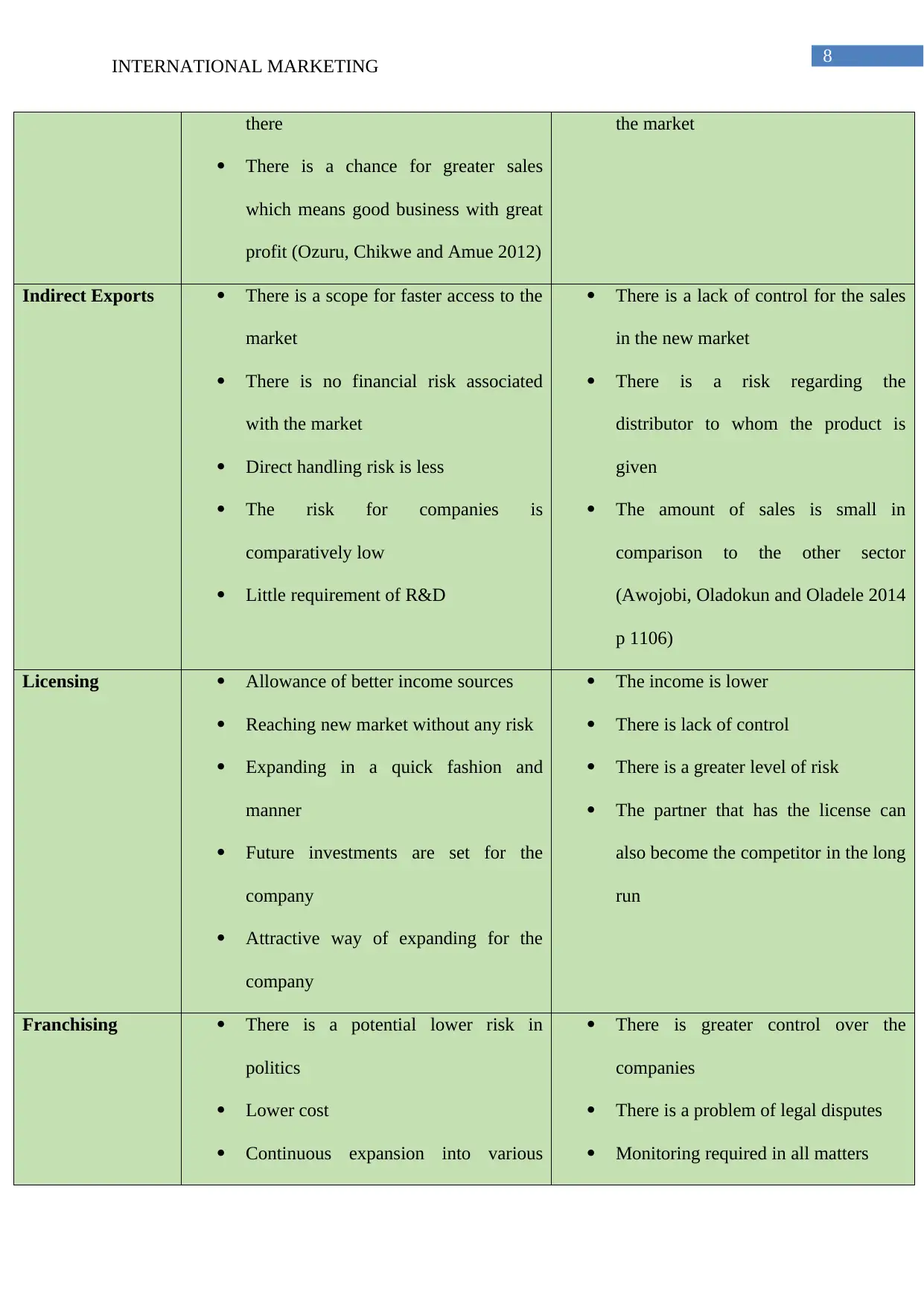
8
INTERNATIONAL MARKETING
there
There is a chance for greater sales
which means good business with great
profit (Ozuru, Chikwe and Amue 2012)
the market
Indirect Exports There is a scope for faster access to the
market
There is no financial risk associated
with the market
Direct handling risk is less
The risk for companies is
comparatively low
Little requirement of R&D
There is a lack of control for the sales
in the new market
There is a risk regarding the
distributor to whom the product is
given
The amount of sales is small in
comparison to the other sector
(Awojobi, Oladokun and Oladele 2014
p 1106)
Licensing Allowance of better income sources
Reaching new market without any risk
Expanding in a quick fashion and
manner
Future investments are set for the
company
Attractive way of expanding for the
company
The income is lower
There is lack of control
There is a greater level of risk
The partner that has the license can
also become the competitor in the long
run
Franchising There is a potential lower risk in
politics
Lower cost
Continuous expansion into various
There is greater control over the
companies
There is a problem of legal disputes
Monitoring required in all matters
INTERNATIONAL MARKETING
there
There is a chance for greater sales
which means good business with great
profit (Ozuru, Chikwe and Amue 2012)
the market
Indirect Exports There is a scope for faster access to the
market
There is no financial risk associated
with the market
Direct handling risk is less
The risk for companies is
comparatively low
Little requirement of R&D
There is a lack of control for the sales
in the new market
There is a risk regarding the
distributor to whom the product is
given
The amount of sales is small in
comparison to the other sector
(Awojobi, Oladokun and Oladele 2014
p 1106)
Licensing Allowance of better income sources
Reaching new market without any risk
Expanding in a quick fashion and
manner
Future investments are set for the
company
Attractive way of expanding for the
company
The income is lower
There is lack of control
There is a greater level of risk
The partner that has the license can
also become the competitor in the long
run
Franchising There is a potential lower risk in
politics
Lower cost
Continuous expansion into various
There is greater control over the
companies
There is a problem of legal disputes
Monitoring required in all matters
⊘ This is a preview!⊘
Do you want full access?
Subscribe today to unlock all pages.

Trusted by 1+ million students worldwide
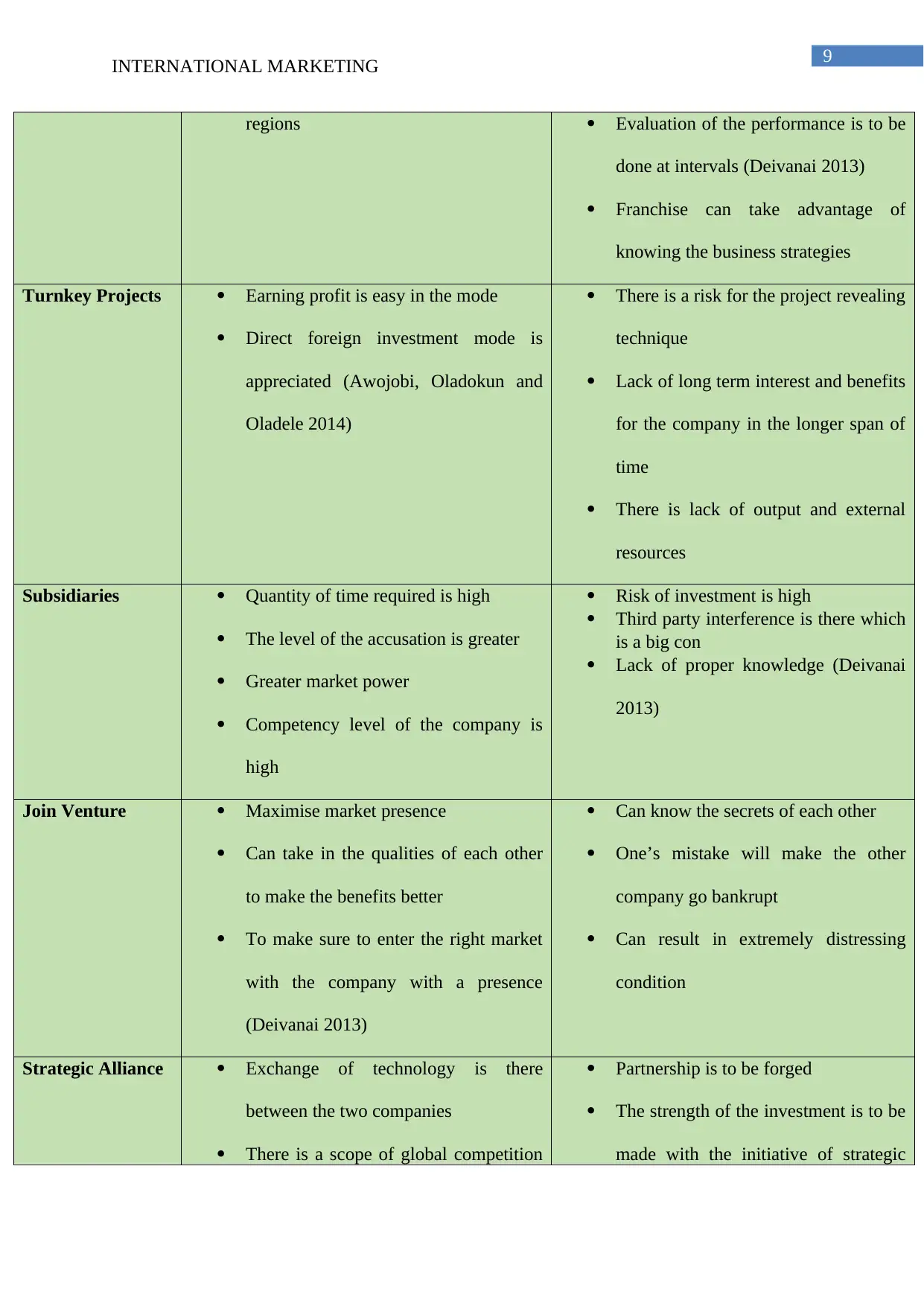
9
INTERNATIONAL MARKETING
regions Evaluation of the performance is to be
done at intervals (Deivanai 2013)
Franchise can take advantage of
knowing the business strategies
Turnkey Projects Earning profit is easy in the mode
Direct foreign investment mode is
appreciated (Awojobi, Oladokun and
Oladele 2014)
There is a risk for the project revealing
technique
Lack of long term interest and benefits
for the company in the longer span of
time
There is lack of output and external
resources
Subsidiaries Quantity of time required is high
The level of the accusation is greater
Greater market power
Competency level of the company is
high
Risk of investment is high
Third party interference is there which
is a big con
Lack of proper knowledge (Deivanai
2013)
Join Venture Maximise market presence
Can take in the qualities of each other
to make the benefits better
To make sure to enter the right market
with the company with a presence
(Deivanai 2013)
Can know the secrets of each other
One’s mistake will make the other
company go bankrupt
Can result in extremely distressing
condition
Strategic Alliance Exchange of technology is there
between the two companies
There is a scope of global competition
Partnership is to be forged
The strength of the investment is to be
made with the initiative of strategic
INTERNATIONAL MARKETING
regions Evaluation of the performance is to be
done at intervals (Deivanai 2013)
Franchise can take advantage of
knowing the business strategies
Turnkey Projects Earning profit is easy in the mode
Direct foreign investment mode is
appreciated (Awojobi, Oladokun and
Oladele 2014)
There is a risk for the project revealing
technique
Lack of long term interest and benefits
for the company in the longer span of
time
There is lack of output and external
resources
Subsidiaries Quantity of time required is high
The level of the accusation is greater
Greater market power
Competency level of the company is
high
Risk of investment is high
Third party interference is there which
is a big con
Lack of proper knowledge (Deivanai
2013)
Join Venture Maximise market presence
Can take in the qualities of each other
to make the benefits better
To make sure to enter the right market
with the company with a presence
(Deivanai 2013)
Can know the secrets of each other
One’s mistake will make the other
company go bankrupt
Can result in extremely distressing
condition
Strategic Alliance Exchange of technology is there
between the two companies
There is a scope of global competition
Partnership is to be forged
The strength of the investment is to be
made with the initiative of strategic
Paraphrase This Document
Need a fresh take? Get an instant paraphrase of this document with our AI Paraphraser

10
INTERNATIONAL MARKETING
level
There is a provision of the convergence
of the industry
There is an introduction in the
economies of scale and a risk stature
It is an alternative to merger
alliance
Targeting in the market is better in the
sense
Strength is the biggest con where one
company’s strength can be the other’s
weakness
INTERNATIONAL MARKETING
level
There is a provision of the convergence
of the industry
There is an introduction in the
economies of scale and a risk stature
It is an alternative to merger
alliance
Targeting in the market is better in the
sense
Strength is the biggest con where one
company’s strength can be the other’s
weakness

11
INTERNATIONAL MARKETING
Part 2
1. About the company - Pizza Hut
Pizza Hut is one of the famous American-origin restaurant and fast food chain that
was founded by Dan and Frank Carney in the year 1958 and is famous for its range of Pizza
and other Italian items including Pasta (Pizza Hut 2018). The company is itself a wholly-
owned subsidiary of the parent concern Yum Brands and is headquartered in Texas. The
American cuisine is one of the best in the whole lot in the province of global cuisine which is
there in the market for about 60 years and running in the course. Pizza Hut (2018) states that
the subsidiary company is basically famous for opening its franchise brands in various
nations of the world including all the developed and developing countries to make sure that
the company which is being listed in the world’s one of the most innovative food restaurant
chains for the manufacture of a number of crust as well as the style pizza is there
2. Evaluation of success or failure of the franchise of Pizza Hut
There are a number of establishing the franchise for the company of Pizza Hut in
various countries of the world which have a level of success or failure in the overall structure
of the place. The evaluation of the success and failure of the franchise mode of market entry
is determined by a number of factors like the success and the failures of the Pizza Hut
franchise in the sect. Ang, Benischke and Doh (2015) states that the total worth of the brand
is approximately $37 billion which is one of the best brands to open a franchise for. The
opening of the pizza franchise for Pizza Hut which is a part of the Yum Foods is there as it is
one of the most popular brands of the global circuit.
Opening a pizza company for Pizza Hut has definitely a lot of affirmatives in the
overall process being one of the bestselling brands all over the globe. The opening of
franchise of Pizza Hut is generally considered as one of the best in the overall sector as it can
INTERNATIONAL MARKETING
Part 2
1. About the company - Pizza Hut
Pizza Hut is one of the famous American-origin restaurant and fast food chain that
was founded by Dan and Frank Carney in the year 1958 and is famous for its range of Pizza
and other Italian items including Pasta (Pizza Hut 2018). The company is itself a wholly-
owned subsidiary of the parent concern Yum Brands and is headquartered in Texas. The
American cuisine is one of the best in the whole lot in the province of global cuisine which is
there in the market for about 60 years and running in the course. Pizza Hut (2018) states that
the subsidiary company is basically famous for opening its franchise brands in various
nations of the world including all the developed and developing countries to make sure that
the company which is being listed in the world’s one of the most innovative food restaurant
chains for the manufacture of a number of crust as well as the style pizza is there
2. Evaluation of success or failure of the franchise of Pizza Hut
There are a number of establishing the franchise for the company of Pizza Hut in
various countries of the world which have a level of success or failure in the overall structure
of the place. The evaluation of the success and failure of the franchise mode of market entry
is determined by a number of factors like the success and the failures of the Pizza Hut
franchise in the sect. Ang, Benischke and Doh (2015) states that the total worth of the brand
is approximately $37 billion which is one of the best brands to open a franchise for. The
opening of the pizza franchise for Pizza Hut which is a part of the Yum Foods is there as it is
one of the most popular brands of the global circuit.
Opening a pizza company for Pizza Hut has definitely a lot of affirmatives in the
overall process being one of the bestselling brands all over the globe. The opening of
franchise of Pizza Hut is generally considered as one of the best in the overall sector as it can
⊘ This is a preview!⊘
Do you want full access?
Subscribe today to unlock all pages.

Trusted by 1+ million students worldwide
1 out of 30
Related Documents
Your All-in-One AI-Powered Toolkit for Academic Success.
+13062052269
info@desklib.com
Available 24*7 on WhatsApp / Email
![[object Object]](/_next/static/media/star-bottom.7253800d.svg)
Unlock your academic potential
Copyright © 2020–2025 A2Z Services. All Rights Reserved. Developed and managed by ZUCOL.





